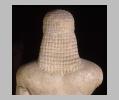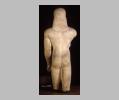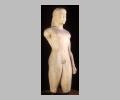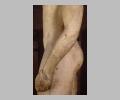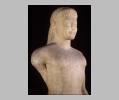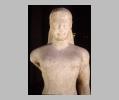| Collection: | Paris, Musée du Louvre |
| Title: | Kouros from Paros |
| Findspot: | Found at Paros, Asklepieion |
| Summary: | Standing nude youth |
| Material: | Marble |
| Sculpture Type: | Free-standing statue: kouros |
| Category: | Single monument |
| Style: | High Archaic |
| Technique: | In-the-round |
| Original or Copy: | Original |
| Date: | ca. 550 BC - ca. 530 BC |
| Dimensions: | H 1.03 m |
| Scale: | Life-size |
| Region: | Cyclades |
| Period: | High Archaic |
Subject Description: Long and slender torso with softly rounded forms. Transitions between parts of the body very smooth. Indications of development include the rounding of the back level with the protrusion of the chest (rather than high on the shoulders), greater curvature of the vertebral column, a fully rounded crown of the head, lips which curve upward at the corners and the beginning of a gradual, more natural turn of the forearm toward the leg where the hand is attached. The sculptor has been conservative in the degree to which he has freed the arm from the body. The arm, however, does show a distinct bend at the elbow. The retention of early forms include the high ear still lacking in detailed anatomical features, lack of indication of neck muscles, a lower boundary of the abdomen defined by straight rather than curving lines leading to the genitals and flanks which are still perfectly level. The hair hangs down in back, the ends forming a gentle curve against the shoulders. The entire mass is treated as rounded beads, except the row of spiral curls which frame the face. A single broad fillet holds the hair in place and emphasizes the curvature of the skull.
Form & Style:
Langlotz once proposed a Parian school of sculpture which he believed produced a number of kouroi. Richter repudiated that theory, attributing the characteristics he cited to chronology rather than to provenance. She noted that the kouroi of the Melos group are remarkably similar in style whatever their place of origin. A large number do come from the islands, however, and there are noticeably fewer examples from Attica than in the preceding or following periods. The Louvre Parian kouros shares the general stylistic traits of slim proportions, restrained modeling and a somewhat generalized rendering of forms. Pedley takes it as a core piece for the Parian workshop he proposes, active from about the middle of the 6th century.
Date Description:
Richter places it early in the Melos Group, which is dated generally to the third quarter of the century. Charbonneaux dates it to ca. 530 B.C.
Condition: Fragmentary
Condition Description:
Missing both legs below the knees and the right arm. Left arm broken in two places and mended. Loss of some of the surface adjacent to the breaks. Part of the chin also broken away. Surface heavily weathered.
Material Description:
Parian marble (Richter)
Collection History:
Found in the northwest corner of the Asklepieion (or northwest of the Asklepieion?), Paros. Purchased in 1910.
Sources Used:
Other Bibliography: AthMitt 27 (1902) 230ff.
